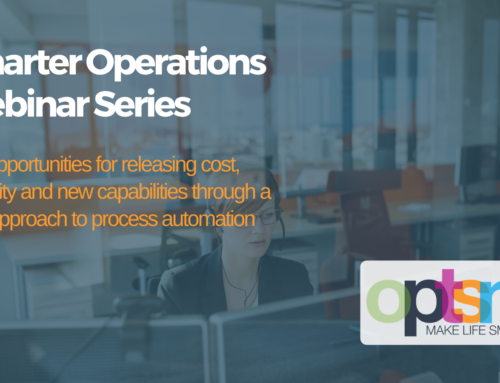Certain kinds of work have remained frustratingly manual for years. It seems that no matter which new software application, which transformation initiative or ‘digitalisation’ programme – there are still PEOPLE bridging the gaps. With fingers on keyboards, eyes on twin-screens – moving data from one place to another to get the job done.
Experience of traditional approaches to software deployments led many to believe that a certain ‘residual’ amount of manual work just can’t be eradicated.
Times have changed. Robotic Process Automation (RPA) – software robots – can now be used in applications that were impossible just a few years ago. But even that technology alone doesn’t hold the answer. Deploying that technology to tackle the small stuff, tasks that are a part of a person’s working day, requires a change in mindset. It’s less like technology development, more like outsourcing. Micro-outsourcing.
Defined, repetitive, brief tasks and projects that are currently done by humans could be out-sourced to a robot – a digital workmate.
That report, pricing document, quote for a client or inbound work request that takes a human 5-10 minutes to produce and send by email? Let a robot do it.
Tasks that seem trivial, tasks that take up a fraction of multiple people’s day. The traditional approach to deploying technology can’t touch them – but when you add up the time and opportunity cost, the benefits of freeing up the human resource is significant.
Small Projects – Big Opportunities for Smaller Organisations
We’ve become conditioned to the way that we deploy technology to improve process. There’s a high cost, significant implementation times and we put a rigorous approach around this to minimise risk.
- Analyse current process and identify necessary change – design a new process model and build a business case for change
- Evaluate technology options and make a decision to buy / build / rent a solution
- Develop the solution
- Test the solution
- Implement the solution (dealing with snags and the pain of change along the way)
It takes months and months to get through and the risks are high because the costs are high.
This makes it tough for small and mid-sized organisations where cash is at a premium and there aren’t the economies of scale that a big bank or utility company can rely on to achieve the pay-off.
But ‘micro-outsourcing’ transforms the experience.
Tasks that have potential can be identified and understood in a few hours. Identifying feasibility is simple. Analysis to understand the process and provide the specification for a robot can be done in 30-45 minutes – merely by observing a current users (with minimal disruption to their normal working day).
From the analysis it is a simple matter of establishing whether it is economic to have the process delivered as a service. If it is, then the robot / digital worker can be ‘trained’ in a couple of weeks.
Once trained, testing the robot / digital worker is simple. It typically requires 2-4 sessions of reviewing the robot carrying out real work to check that it is following rules correctly. After each of these sessions the training is adapted until all variations of the ‘task’ are accounted for. Each of the testing sessions (or demonstrations) typically takes 30-45 minutes.
It is now possible to deliver the process as a managed service. Providing the process as a service around the existing human team’s activities is simply a scheduling exercise. Delivery of the ‘live’ activity has taken 3-4 weeks.
The impact can be huge – here are some process examples:
- Receiving inbound work requests from multiple sources and turning them into active jobs on an operational system – READ MORE>
- Generating quotations for potential clients by gathering pricing information from multiple sources based on client requirements – READ MORE>
- Adding, vetting and activating a new client
- Gathering manually entered information from field-based staff, fixing errors / anomalies and compiling into a regularly published report
- Finance Processing; Accounts Payable, Accounts Receivable and Bank Reconciliation
A No-Overhead Model is Key to Success
The large banks, utility companies, government departments are all deploying Robotic Process Automation and spending millions on the technology. But they are doing it the traditional way – up-front investment leading to long-term payback.
Micro-outsourcing via a Pay-per-process model is the ideal alternative.
It allows a business to identify and tackle points of value for immediate pay-back. The benefits derived from automating the process are aligned to spend – delivering to the business in weeks.
The model builds its own momentum. As managers and staff understand the opportunities and technology then more winning candidates for automation are identified.
As more tasks are micro-outsourced, economies of scale can be achieved. This lowers the threshold for additional tasks as the cost to delegate them to a robot / digital worker is reduced – making it possible for more human capacity to be released for higher value activities.
Releasing Productivity Lock
Clearly the main drivers for automating mundane, repetitive tasks is productivity and cost-saving. But this approach creates capacity for growth and transformation – it provides the time and space for an organisation to better understand processes and opportunities for optimisation.
Bigger change becomes easier to manage once the front-line experts are able to take the time to look at how it can be done better. Change is easier to implement when there are digital workers available to pick up the slack. Post-implementation pains of new systems are removed because robot resource can test more intensively and can support workarounds during changeover.
Think Small, Act Fast, Win Big
Productivity lock is 30% of an organisations back-office costs. Productivity Lock is the constraint on organisations created by people having to act as the bridge between software islands – applications that don’t quite meet in the middle.
Micro-outsourcing to digital workers can release the people and streamline the work that is creating cost and delays.
Small opportunities generate lots of little time and cost-savings that can add up quickly.
With micro-outsourcing, starting small and acting fast can lead to big returns.






Leave A Comment